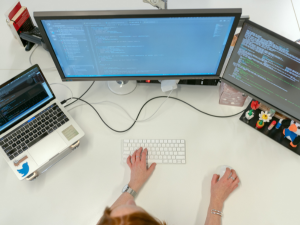 Technology makes remote work possible. Unfortunately, the tools that allow workers to access their workplace networks from afar can also open the door to hackers and their harmful ransomware.
Technology makes remote work possible. Unfortunately, the tools that allow workers to access their workplace networks from afar can also open the door to hackers and their harmful ransomware.
The latest ransomware warning involves TeamViewer, software that allows users to access a company network from anywhere, view specific endpoints as if they're sitting in front of them, and transfer data. However, if a hacker finds their way into the program, they can do all of this too — and infect the entire network with ransomware.
Here's what you need to know to watch out for this new ransomware threat and how to respond.
Alert: Emerging Ransomware Threats Target TeamViewer
Previously, hackers used TeamViewer as an access point to corporate networks to steal information and wreak havoc, even though TeamViewer is a secure program that lacks vulnerabilities that attract cybercriminals. Hackers exploited user behavior by launching brute-force attacks to guess their credentials and slip in undetected.
In recent unsuccessful incidents involving TeamViewer, hackers used encryptors associated with known ransomware groups. Although antivirus software and an immediate response stopped these attacks, clearly TeamViewer remains an attractive target.
With that in mind, companies must remain alert, watch out for this new ransomware threat, and take steps to thwart it.
Protecting Your System From the Newest Ransomware Variant
Managing user behavior is the best way to address the threat of TeamViewer-spawned ransomware attacks. Staying vigilant against new ransomware attacks requires constantly evaluating cybersecurity strategies, preparing to pivot, and educating team members about ransomware and their role in stopping it.
Rock Solid Password Management
What you need to know about the latest ransomware menace is that its success relies on lax password management. Easy-to-guess credentials, the reuse of login information, and ignoring best practices for password length or character requirements are surefire ways to invite an attack. Require employees to make strong passwords, change them frequently, and implement tools to prevent reusing credentials elsewhere.
Implement Multi-Factor Authentication
Multi-factor or two-factor authentication prevents access by requiring more than just a username and password. An additional token for access to any cloud-based or remote tool prevents anyone from circumventing security.
Never Skip Updates
Installing operating system and software updates prevents hackers from discovering and exploiting vulnerabilities to deploy ransomware.
Communicate and Educate
A constantly evolving threat landscape means you must keep your team up to speed on the latest threats and protocols for mitigating them. Unveiling the dangers of recently identified ransomware in ongoing updates keeps everyone up to speed. When people know their role in protecting the company and have the tools to do their part, there's a lower risk of a successful cyber incident.
Make Backups a Priority
If ransomware somehow infiltrates your network, secure backups keep data out of the wrong hands. Store daily backups separate from the primary network.
Don't Let Your Guard Down When It Comes to Ransomware
A ransomware attack can devastate your business. TeamViewer is once again an attractive target for actors with malicious intent, so watch out for this new ransomware and take precautions to stop it.



